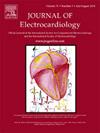心脏再同步化治疗后如何纠正QT间期。
IF 1.2
4区 医学
Q3 CARDIAC & CARDIOVASCULAR SYSTEMS
引用次数: 0
摘要
本研究评估了用于校正宽QRS复合物患者QT间期的各种公式,以计算心脏再同步治疗(CRT)后校正QT间期(QTc)。方法:我们纳入了严重心力衰竭和左束支阻滞的患者,QRS持续时间至少为120毫秒,并成功植入CRT。如果患者在植入前有非外侧左心室导联、代谢紊乱、心房颤动、房性心动过速或高度房室传导阻滞,则排除。采用Boggosian、Wand、Rautaharju、Yankelson、Tang & Rabkin、Bazett、Framingham、Hodges和Fredericia公式测量植入前后QT间期,并校正QRS持续时间和心率。结果:共有51例患者符合研究标准。CRT后,QRS持续时间由189.68±18.06毫秒显著缩短至165.25±18.78毫秒。然而,使用Bazett公式修正的QT间期没有显著变化(522.30±33.37毫秒vs 524.06±36.52毫秒)。在各种校正方法中,结合波格西甘公式(QRS持续时间)和霍奇斯公式(心率),或Rautaharju公式和Fredericia公式,产生了可比较的QT间期。同样,用Fredericia公式校正心率,然后用Rautaharju公式校正QRS,结果一致。结论:我们的研究结果表明,校正QT间期心率和QRS持续时间的不同公式可能会产生不同的结果。值得注意的是,在Hodges公式之后使用bogossip公式,或Rautaharju和Fredericia公式的组合,在CRT前后产生相对一致的QT间期。需要进一步的研究来验证这些发现。本文章由计算机程序翻译,如有差异,请以英文原文为准。
How to correct QT interval after cardiac resynchronisation therapy
Introduction
This study evaluates various formulae used to correct the QT interval in patients with wide QRS complexes to calculate corrected QT (QTc) following Cardiac Resynchronisation Therapy (CRT).
Methods
We included patients with severe heart failure and left bundle branch block, presenting with a QRS duration of at least 120 milliseconds, who underwent successful CRT implantation. Patients were excluded if they had non-lateral left ventricular lead placement, metabolic disorders, atrial fibrillation, atrial tachycardia, or high-degree atrioventricular block prior to implantation. QT intervals were measured pre- and post-implantation and corrected for QRS duration and heart rate using the Boggosian, Wand, Rautaharju, Yankelson, Tang & Rabkin, Bazett, Framingham, Hodges and Fredericia formulae.
Results
A total of 51 patients met the study criteria. After CRT, the QRS duration significantly decreased from 189.68 ± 18.06 milliseconds to 165.25 ± 18.78 milliseconds. However, the QT interval corrected using Bazett's formula showed no significant change (522.30 ± 33.37 milliseconds versus 524.06 ± 36.52 milliseconds). Among the various correction methods, the combination of the Bogossian formula (for QRS duration) followed by the Hodges formula (for heart rate), or the Rautaharju formula followed by the Fredericia formula, produced comparable QT intervals. Similarly, correcting heart rate with the Fredericia formula followed by QRS correction with the Rautaharju formula yielded consistent results.
Conclusion
Our findings indicate that different formulae for correcting QT intervals for heart rate and QRS duration may yield varying results. Notably, the use of the Bogossian formula followed by the Hodges formula, or the combination of the Rautaharju and Fredericia formulae, produces relatively consistent QT intervals before and after CRT. Further research is needed to validate these findings.
求助全文
通过发布文献求助,成功后即可免费获取论文全文。
去求助
来源期刊

Journal of electrocardiology
医学-心血管系统
CiteScore
2.70
自引率
7.70%
发文量
152
审稿时长
38 days
期刊介绍:
The Journal of Electrocardiology is devoted exclusively to clinical and experimental studies of the electrical activities of the heart. It seeks to contribute significantly to the accuracy of diagnosis and prognosis and the effective treatment, prevention, or delay of heart disease. Editorial contents include electrocardiography, vectorcardiography, arrhythmias, membrane action potential, cardiac pacing, monitoring defibrillation, instrumentation, drug effects, and computer applications.
 求助内容:
求助内容: 应助结果提醒方式:
应助结果提醒方式:


